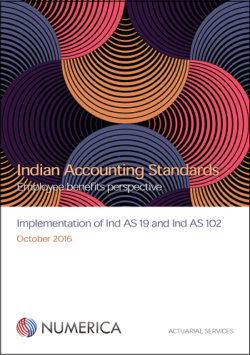
With the rise in start-ups in India, we are observing an increasing trend in share-based remuneration schemes to the employees, the most popular ones being ESOP and SAR. However, we have observed a gap amongst professionals and company personnel, in the knowledge of the different types of schemes and their accounting treatment. As such, in this post we have tried to cover these schemes, respective actuarial valuation methodology and the accounting treatment, especially from an Ind AS 102 (and/or IFRS 2) perspective.
Classification of share-based payments
Though there may exist several types of share-based remuneration schemes and some of them quite innovative, we restrict our focus on two broad types, which are also most widely used:
- ESOP: Employee Stock Option Plan
- SAR: Share Appreciation Right
The above schemes fall under the purview of Ind AS 102 since the accounting standard applies to all share-based payment transactions, whether equity-settled and/or cash-settled.
Quick Quiz: ESOP vs SAR
Question 1: Can you guess which one of the following scenarios is an ESOP and which one is SAR?
Scenario A: An employee is granted an option* to buy 100 shares, after 5 years, at current market price.
Scenario B: An employee will receive the (incremental) difference between the current share price and the prevailing share price after 5 years, for 100 shares.
Question 2: A startup founder wants his team to have a share in the growth of the company. However he does not want to dilute his shareholding or lose any control. Which scheme should he opt for, ESOP or SAR?
*An option (call option) is a right, but not an obligation, to buy an underlying security at a particular time, at a predetermined price.
Answer 1: Scenario A = ESOP; Scenario B = SAR.
Answer 2: SAR.
In SAR scheme, the employee is entitled to a share in the growth of the company (paid in cash or equivalent). However, he/she is not allotted any shares, whereas in ESOP the employee is allotted the shares (and thus the benefit in growth of the company).
Valuation approach
Ind AS 102 mandates a fair valuation of share-based remuneration schemes (whether stock options, i.e. ESOP or SAR). However, it does not mandate the use of any particular method of valuation.
Fair value is the amount for which the equity instrument granted can be exchanged, between knowledgeable and willing parties in an arm’s length transaction.
As defined in Ind AS 102
Having said the above, Black Scholes formula is the most popular method for option valuations. The other methods such as a Binomial model or Monte Carlo method are not as popular because of the complexity and the cost-benefit factor. To know more details about these 3 methods, please click here.
Please note that the valuation approach for both ESOP and SAR is similar – the only difference being in the model parameters such as Strike Price, value of the underlying share, etc.
Irrespective of the valuation method used, as per Ind AS 102, all option pricing models must at least take into account the following 6 factors:
- the exercise price of the option;
- the life of the option;
- the current price of the underlying shares;
- the expected volatility of the share price;
- the dividends expected on the shares; and
- the risk-free rate of interest for the life of the option
In addition to these, the factors that “knowledgeable, willing market participants” would consider in setting the price shall also be taken into account.
Accounting treatment as per Ind AS 102
The accounting treatment, including valuation frequency and recognition principles, vary between different types of schemes. Let us have a look at each one separately:
- ESOP:
- Equity-settled payments basis
- One-time valuation at grant date (Balance sheet related)
- Exception: In case of modifications to the plan, for instance, change in the exercise price. If the modification results in:
- Increase in fair value: such incremental fair value is recognized over the remaining vesting period.
- Decrease in fair value: we continue to recognize such expense at original cost (i.e. based on the fair value prior to modification).
- Exception: In case of modifications to the plan, for instance, change in the exercise price. If the modification results in:
- Recognition principle (P&L related): Depends on vesting period
- If ESOP vest immediately, recognize the entire amount in full
- If ESOP vest in future, then to be recognized over the vesting period
- SAR:
- Cash-settled payments basis
- Valued at each balance sheet date
- Modifications do not change the valuation approach as they have to be remeasured at each balance sheet date in any case.
- Recognition principle (P&L related):
- Any change in fair value is recognized in the P&L.
- If SAR vests immediately, recognize the entire amount in full
- If SAR vests in future, then to be recognized over the vesting period
To read full text of Ind AS 102, please click here
Conclusion
- ESOP and SAR are the most popular share-based remuneration schemes
- More complex schemes which use a combination of share-settled and equity-settled payments also exist. To discuss these in detail, please feel free to contact us.
- Ind AS 102 does not mandate any specific method of valuation. However, Black Scholes method is the most popular method.
- ESOP valued at time of grant, whereas, SAR valued at each balance sheet date
- Both ESOP and SAR expenses to be recognized linearly over the vesting period
______________________________________________________________________________
Download our white paper on transitioning to Ind AS from an employee benefits perspective (Ind AS 19 and Ind AS 102):

